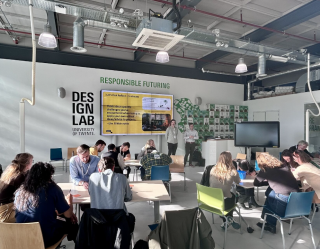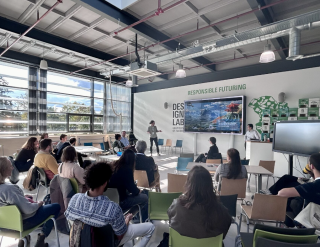The workshop was aimed to bridge the gap between the academic work on ethics of technology into real-world applications by working through a 3 stepped letter to ‘future explorers’ of responsible technologies. The participants discuss and collect shared challenges, tech-agnostic responsible tech practices, and concrete advice. For each step, participants brainstormed and discussed with post its.
By filling in post its of personal obstacles encountered when integrating ethics into technological projects during their work, the participators gave rise to valuable insights on current difficulties when bringing ethics into practice.
Assessing these difficulties brought to light the similar landscapes we navigate through when putting ethics into practice. Therefore, participants put together tech-agnostic ethical practices.

Step 1: On our quest to integrate ethical wisdom into technological projects, we’ve stumbled upon treacherous waters. The specific obstacles we’ve faced included:
- The lack of transparency between developers about goals when designing new technologies. It’s hard to find the right approach to start conversations about ethical implications and the practical applications of new technologies. How do you start these conversations, and what are the right questions to ask? How do you decide on important values to shape the decision-making progress? How do you structure interactions in disciplinary dialogues?
- Co-creating is complex. Especially when co-creating a technology together with different people with different expertise. Ethicists are sometimes not educated enough in technology, leading to the ethics expert being a bit ‘large-mouthed’. However, technicists often tend to aim at legitimation by applying ethical checklist, leading to the risk of ‘ethics-washing’ in the project. Ethicists and technologists should deliberately practice co-creation.
- A lack of alignment and priority. Often there is a different way of thinking between academia and non-academia and there is only one (or a few) person(s) in a team responsible for ‘doing the ethics part’, leading to ethics becoming a compliance activity.
- The complexity of bringing ethical theories to practice. At this point, ethical theories seem to either be too complex to put theory into practice or too simple such that all interpretations are possible. Theories are often need while putting them into practice results in a messy process. Also there seems to be a resistance to discussing abstract ideas.
Step 2: By sharing our maps, we’ve uncovered that many of us navigate in similar landscapes. The universal, tech-agnostic ethical practices we’ve found along our journey are:
Transparency:
- There is a need to create space for dialogue, including all relevant and broad stakeholders in transdisciplinary conversations, enabling cultivated shared expertise and transparency. This is at the risk of not proceeding with a project (which should be acceptable).
- There is a need for transparency in the decision-making process when creating technology. Not only transparency on the best practices but also transparency about failures and mistakes.
Active responsibility:
- Active responsibility of all contributors in the design process is needed, enabling transparent communication and space to embrace the ambiguity of doing ethics.
- Ethicists (or responsible tech professionals) in the process of co-creating a technology must be epistemically humble and listen to those with (technical) domain expertise during dialogues. At the same time, they need to be brave and speak up when they see something that is problematic.
- Technologists and other contributors should be able to know how to apply ethics themselves as well. Even if there is no ‘ethical guidance’ they should still be able to do the right thing.
Ways of working:
- Integrating ethics throughout the entire development cycle should be participatory and iterative.
- Responsibly handling technologies is done well when instead of taking the technology as a starting point, values are taken as a starting point.
- Putting values and ethics at the center of a project allows for further development and innovation.
- Working with focus groups.
- Making ethical considerations in the proposal stage of a project, before the funding takes place.
- We could consider ethicists taking the role of project regulators (e.g. moresprudence).
- Not proceeding a project because of ethical implications should become more acceptable.

Step 3: Let’s collaboratively forge a compass – an advised course towards better technologies – that points us all toward bringing ethics into practice.
Due to all the enthusiastic discussions, and perhaps optimistic planning from our side, we did not manage to fulfill this last step. However, we can extrapolate from the conversation the following:
For ethics or responsible tech professionals:
- Be humble and brave. You have a vital role in shaping the ethical direction of a project. This requires both humility and courage. Don’t shy away from raising the right concerns when you see something problematic. It’s your responsibility to make others aware of ethical complexities that may not be immediately visible.
For project leadership:
- Start the project by focusing on the core problem and the underlying values you want to prioritize in the project.
- Create room for iterative and participatory practices. As project leader, you are responsible for creating an environment that encourages ethical reflection at every stage of the project.
- Have value-driven conversations with your team. Ensure that values are not just abstract. Make them central to the decision-making process at all stages of technological development.
- Not continuing a project or significantly changing direction due to ethical concerns should be a possible outcome of ethical reflection.
For engineers and experts:
- Even without ethical guidelines, you should still be trying to do the right thing. You have a responsibility for your work and its broader impact. Be aware that you are not just simply making a technology. You are developing tools that people will use and be affected by in everyday life.
- Be proactive in questioning the potential consequences of your design. Make sure you align your work with public values by closely working together with ethicists and embracing the complexity of ethical decision-making.
We felt lucky to have both our invited guests and the 4TU ESDIT community in this session. The exercise of our session helped this group of researchers and thinkers share their side of the story. We noticed that for this group the obstacles they face emerge from discussions with people working in policy, advising and even strategy. Step 2 had creative and unique answers, the groups’ extremely mixed academic backgrounds garnered great feedback for what could be considered ‘tech-agnostic ethical practices’; or in other words, feedback on what could be responsible tech practices for any technology. Step 3 takes inspiration from the first two sections and tries to make sense of what we have seen in our work on responsible tech at SURF while weaving in the thoughts we heard at this conference session.
We hope these insights are also of value for the broader community of research and education. Within Responsible Tech at SURF we aim to help our members (the research and education institutions of the Netherlands) innovate better and more responsibly. Looking ahead, we look forward to hosting, facilitating, and creating space for responsible tech and public values discussions.
We thank our invited roundtable members for joining us and the 4TU ESDIT community for having us for this great event!
If you are interested in our work, follow the ‘publieke waarden’-community on SURF Communities or let us know at responsibletech@surf.nl



0 Praat mee